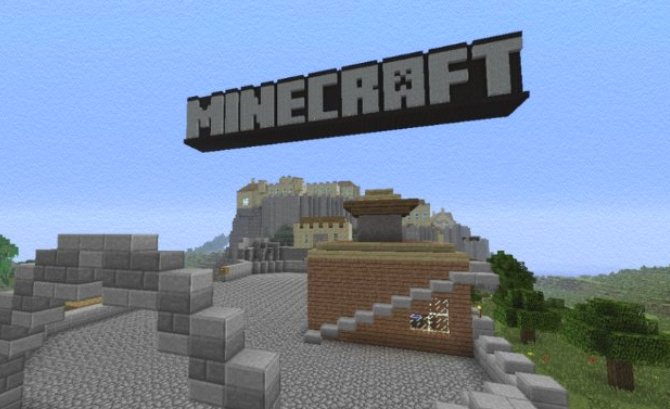
by Stone Marshall | Jun 28, 2015 | Minecraft News |

Developer 4J Studios, the development studio responsible for porting Minecraft to the Xbox and Playstation, is now seeking player feedback to find out what content fans would like to see become the next DLC for the sandbox creation game. On the developer’s official Twitter account, 4J Studios has asked the Minecraft community which Sony-owned franchises should be considered to be represented in upcoming downloadable add-ons for Minecraft.It’s interesting to see the studio seeking fan input on new Minecraft content specifically for Playstation platforms considering that Microsoft purchased Minecraft creator, Mojang, earlier this year. This is just further proof that Microsoft legitimately meant that they plan to continue supporting the voxel-based title across all platforms despite the fact they could have easily decided to turn the widely popular franchise into an Xbox console exclusive.
Playstation owners will likely be pleased to see more DLC available for the PS4, PS3, and PS Vita versions of Minecraft. Since the series existed on Xbox platforms for more than a year before appearing on Sony consoles, Playstation gamers have access to fewer pieces of DLC.
Thankfully, that may soon change since 4J Studios is now seeking feedback for new Minecraft mash-up packs based on Sony titles. In the past, Playstation owners have had to wait long periods before being able to play similar DLC packs such as the Skyrim Mash-up Pack. The prospect of new Sony-specific Minecraft add-ons would likely give Playstation platforms exclusive access to the upcoming content.

Minecraft – 4J Studios
The Playstation editions of Minecraft have seen a few skin packs inspired by Sony games such as The Last of Us, there has never been a full mash-up pack available exclusively on the PS3 and PS4. While Minecraft‘s popular skins packs allow console users to change the in-game appearance of their Minecraft avatar, mash-up packs completely change nearly every aspect of the block-filled game.
In addition to including character skins, mash-up packs also completely alter world textures in order to create an entirely new Minecraft experience, these comprehensive DLC packs also change the music of user interface of the game to more closely resemble the licensed property that the add-on is based on.
As 4J Studios looks for fan input, Mojang is busy working on an upcoming Minecraft update that will fully redesign the combat mechanics of the game. Mojang’s Searge tweeted a screenshot earlier this week that shows off the new equipment system that the developer is currently designing.
What Playstation titles would you like to see recreated in Minecraft with a new mash-up pack DLC?
‘Minecraft’ Dev Wants To Know What Playstation Games You Want To See As Future Mash-Up DLC
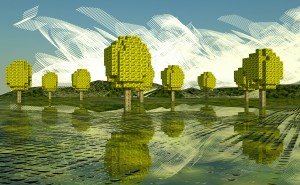
by Stone Marshall | Jun 28, 2015 | Minecraft News |
A multi-player server on the wildly popular video game Minecraft has introduced bitcoin to its world as a way of teaching children about digital currency.
While in-game currencies exist in several different minecraft worlds, using bitcoin means that players can take their money out of the game and use it in the real world too.
The server, PlayMC, features an in-game currency called ‘bits’ which the company has set at 100,000,000th of a bitcoin (commonly known as a ‘satoshi’). The unit was chosen for its ease-of-use, as it represents a whole unit and allows players to be rewarded seemingly on a larger scale.
With additional opportunities for players to spend their bits on classes, items and other additional content within the game, PlayMC says it provides a “safe gaming environment for kids to enjoy and have the opportunity to earn their own money”.
Minecraft for the uninitiated
As the third best-selling video game of all time, Minecraft has sold over 60 million copies. Especially popular with younger people, it allows players and game developers to build worlds from 3D blocks not unlike digital Lego.
Everything in the game is based on these blocks, which can either be destroyed or moved and placed to create anything within a player’s imagination. It is an open-ended world with a high degree of flexibility as to what is possible, though some elements of the world are consistent across the different games.
Players can play alone or connect to servers like PlayMC, allowing multi-player games and interaction in the online world with thousands of other players.
Plugins allow game creators to determine the nature of play and objectives of the game, which usually involves players acquiring resources in order to build tools and structures, and sometimes fight off enemies.
PlayMC’s bitcoin economy
PlayMC’s server has plugins that change the main Minecraft game into mini-games, where players either cooperate or fight against each other to win. Each game has different objectives and different ways for players to earn their bits.
A company spokesperson said:
“For example in our game type ‘ArcherGames’ players fight each other in a last man standing game mode. Each player is rewarded a small amount of Bits for killing other players and if they come in first, second or third they are rewarded with a larger amount of Bits.”
As well as awarding bits for standard play actions like kills and wins, PlayMC also allows its players to earn them for winning tournaments and powerups, and in non-game actions like bug reporting, blog post writing, bounties, and acting as server staff.
No parents had yet approached the company for more information on bitcoin but plenty of young players have been actively trying to understand digital currency, the spokesperson said.
Most of the team’s time is now spent clearing up misconceptions about bitcoin and providing links that explain bitoin in simple terms.
PlayMC also has an extensive explanation of bitcoin and its in-game ‘Bitconomy’ on the company website.
E-commerce for kids
PlayMC follows in the footsteps of other bitcoin-oriented Minecraft servers such as BitQuest, though PlayMC is aimed specifically at children.
One of bitcoin’s touted advantages is the way it provides access to electronic payments to those under 18. Children generally have restricted access to banks or credit card accounts.
Of course, anyone wishing to turn their bits into fiat currency will still need to go through a bitcoin exchange, which have similar verification requirements to banks. This could actually promote a bitcoin-based economy by engaging users who can’t easily escape it.
PlayMC was founded from a partnership between AcroMedia and developer Brandon Gordon, the latter of whom has been involved with Minecraft for five years and bitcoin for three. Given his personal interests, incorporating bitcoin into the game “seemed like a no-brainer,” he said.
The server was founded to introduce new levels of reliability to Minecraft, which often have an ‘anything goes’ reputation and servers come and go with regularity.
It boasts 99.9% uptime and is regularly updated to the latest Minecraft version. Its community is always able to make suggestions and the focus is being as kid-friendly as possible.
Kid-Friendly Minecraft Server Launches Bitcoin Economy
![[Update: Released] Minecraft: Pocket Edition 0.11.0 update will finally be jumping out of beta and going live this week](https://www.stonemarshall.com/wp-content/uploads/Minecraft-Pocket-Edition-Boats-Android.jpg)
by Stone Marshall | Jun 27, 2015 | Minecraft News |
If you’ve been in the version 0.11.0 beta since it began a few months ago, you’ve probably been enjoying a lot of the upcoming features we’ve been reporting on. Well it finally appears that everyone without beta access will be able to play all the new features in version 0.11.0 soon as the update will finally be leaving beta and going public onto Google Play later this week.
Update: June 4th, 2015 8:22am PST: Mojang has finally released the Minecraft: Pocket Edition 0.11.0 update onto Android. It was supposed to arrive last week but for whatever reason it wasn’t. Instead it has been released today, which isn’t bad. It could have been much longer of a delay. If you have Minecraft: Pocket Edition installed, you should be able to see and download the update now.
For those of you who missed our previous coverage, there is a lot coming to the game with this update. There will be a new female character model named Alex that people can play as well as custom skins finally making their appearance officially in Minecraft: Pocket Edition. Boats will also be arriving, including different wood variants and the ability to hold two people. Fishing will also be arriving in version 0.11.0 as well as Squids. In fact there is a few new mobs arriving including baby zombies, cave spiders, and more.

Boats!
Here is the full changelog for version 0.11.0:
– Multiple language support
– Boats with space for two! Take your pet for a pleasant ride.
– The ability to throw stuff from boats, including snowballs and eggs
– Fishing! Now you can fish for fishies!
– Squids!
– Spider jockeys!
– Cave Spiders!
– Bats!
– Adorable baby zombies!
– Weird chicken jockeys!
– Edible clownfish. Yum!
– A fancy new World Edit screen so you can rename worlds, change game modes and do other things
– Creative players can no longer be set on fire. Controversial
– We’ve stopped cheeky chickens from walking on water
– Animals can no longer breed without touching each other ooh err
– Drinking milk now removes mob effects
– Ridiculous amounts of bug fixes
– More cool things that you should discover for yourself

Potion Effects
The last thing in that changelog is probably referring to things like potion effects which will be included in this update even though potions, as an item, will not be arriving in version 0.11.0. There will also be pressed Dirt blocks and other little goodies which we have covered while playing in the beta for version 0.11.0.
So when can you get your hands on this update? Version 0.11.0 for Minecraft: Pocket Edition will be arriving later this week, although no specific date was announced. It will most likely be either Thursday or Friday. We will post an update once it launches.
[Update: Released] Minecraft: Pocket Edition 0.11.0 update will finally be jumping out of beta and going live this week
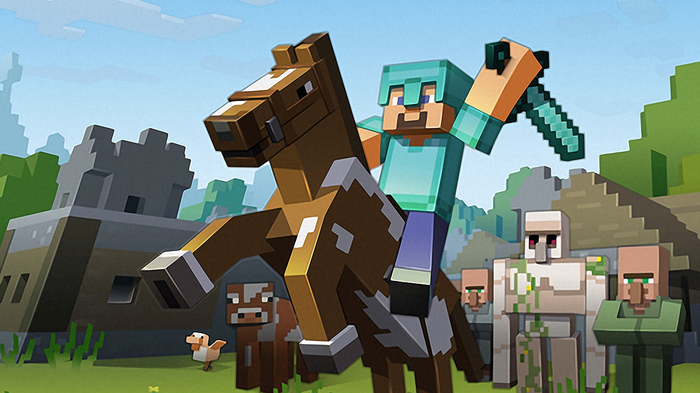
by Stone Marshall | Jun 27, 2015 | Minecraft News |
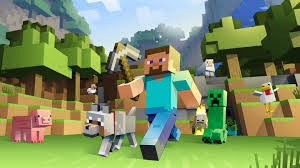 Parents might be happy to know their kids can get a head start in the competitive slipstream of computer programming by doing something they already enjoy — playing video games.
Parents might be happy to know their kids can get a head start in the competitive slipstream of computer programming by doing something they already enjoy — playing video games.
That’s the goal of Server Design 1, a new online course rolled out Tuesday by Youth Digital, a tech education company that teaches kids to code, develop apps, and design 3D modeling. The company’s new program allows kids to create their own worlds, with their own rules, all while playing the popular video game Minecraft with their friends.
“You get to add things that you would never ever, ever, ever be able to do without a programming interface,” said 10-year-old Ronan, an early adopter of the new tech tool who’s become well-versed in developer lingo while not losing that kid’s perspective. “You can create skeletons wearing iron doors. How weird is that?”
The interface he’s talking about is a unique Java server, part of a yearlong subscription (for $250) to curriculum, tools and a hosting service with Youth Digital, where kids custom-code their own Minecraft environments, characters and scenarios.
Minecraft, a “virtual Lego” video game that’s a runaway hit with younger players, is made by Mojang, a Swedish game maker purchased last year by Microsoft for $2.5 billion. The game provides an infinite digital sandbox where kids can dig and build different kinds of 3D blocks. Or, as Ronan explained in a Youth Digital video: “I can turn a blank screen into a virtual playground.”
With the burgeoning programming and development job market, code literacy has become an increasingly popular part of higher education curriculum. Parents, schools and future employers have been pushing to integrate the developer’s languages — JavaScript, HTML, CSS — as early as grade school to give kids a head start. One stumbling block is making the methodical, typing-intensive learning fun for kids.
But Justin Richards, founder and CEO of North Carolina-based Youth Digital, says there’s a natural connection between kids’ penchant for creativity and the complex world of computer programming.
“If you tell 9-year-olds that coding experience will help them get a job in the future, they might not be too interested,” said Richards. “But if you ask them if they want to create a video game, they’ll answer yes every time.”
This isn’t the first time Minecraft has been repurposed for the classroom.
The Australian government funds a competition for school children that challenges participants to design their “perfect national park” using Minecraft as a design medium. And MinecraftEdu, which makes a custom edition of the game specifically for classroom use, offers discount licenses to schools.
But the Server Design 1 program puts the kids, ages 8 to 14, right in the driver seat. “This matches science and storytelling into a singular project,” Richards said. “It’s exploratory and just plain cool to actually get to modify the code and change the game that you love.”
The simple concept behind this and all of Youth Digital’s programs, he said, is to “turn the youngest consumers of technology into its creators.”
Teaching kids to code, using Minecraft’s building blocks
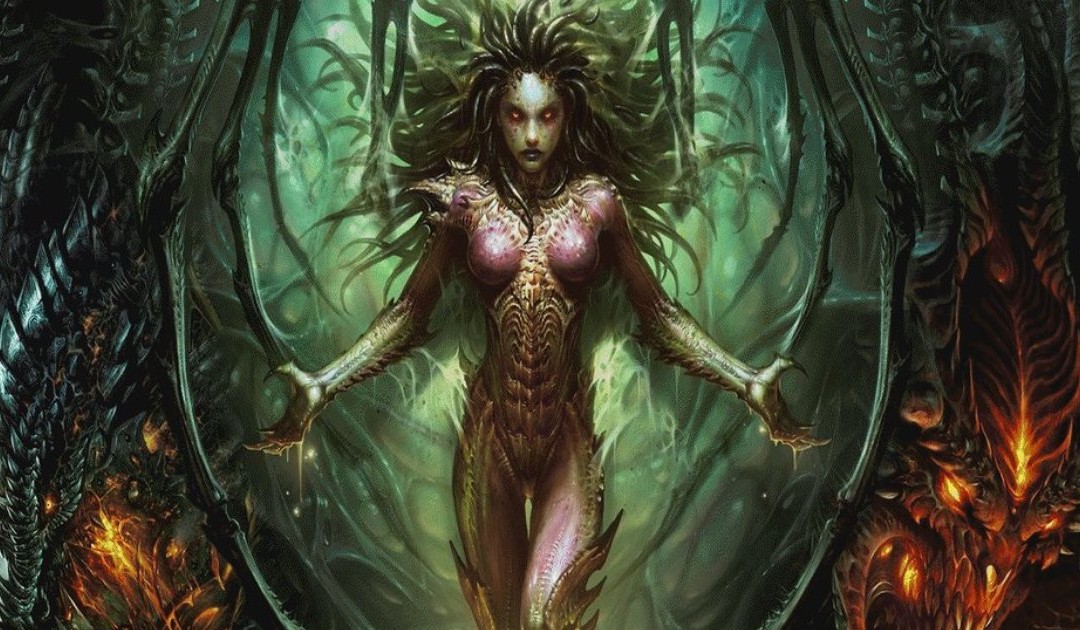
by Stone Marshall | Jun 26, 2015 | Minecraft News |
 Thorlar Thorlarian describes himself as a “Pixel Art King,” and that’s not an empty boast. Witness his recreation of this BlizzCon 2010 wallpaper in Minecraft: It’s made up of over 1.1 million blocks, and took him more than 23 weeks to create. Even crazier, he did the entire thing by hand, without the aid of any external software or other artists.
Thorlar Thorlarian describes himself as a “Pixel Art King,” and that’s not an empty boast. Witness his recreation of this BlizzCon 2010 wallpaper in Minecraft: It’s made up of over 1.1 million blocks, and took him more than 23 weeks to create. Even crazier, he did the entire thing by hand, without the aid of any external software or other artists.
“Pixel art, when it comes down to it, is just like drawing with pen and paper. So with enough practice, it’s easy to know what blocks have what color, such as black being best represented by by black wool, coal blocks, etc. At that point, no matter the size of your project, all you need to do is know what block would be most suitable for what area,” he told us. Of course, you also need the time and the tenacity to see it through to the end. “It took over 1000 hours, so it’s not something you just plan to do overnight or in a week,” he added.
A video of the final moments of the image’s creation, followed by a flyover, demonstrates just how massive it really is. Even with the render distance set to maximum, we don’t come close to seeing the whole thing until he zooms out to a world map view. Thorlar claims that the 1,128,960 blocks used in the image represents an actual world record as the biggest Minecraft pixel art ever, with thousands of Twitch witnesses to confirm the legitimacy of the accomplishment.
Livestreaming the creation of the image also earned roughly $3500 for charity, including $1337 in one hour on the final day, most of which went to Make-A-Wish Ireland. In fact, he’s raised roughly $11,000 for charity since March 2014, shortly after he became a Twitch partner.
“I told myself, ‘If I ever get so much support I get partnered, we’re doing charity as much as we can.’ As we’ve kept growing, the effort has too,” he said. “The bigger we’ve grown, ever so steadily, the faster we’ve been able to raise money, and it makes me happy to see how much of a difference games can make for charity and the less fortunate… I love seeing what games can do for people. Not just cheering people up on a bad day, but giving people clean water, helping research cancer, etc.”
A closer look at what went into Thorlar’s amazing creation may be found in this Reddit AMA posted earlier today, which also includes a link to the Dynmap for those who’d like to check it out in all its humungous glory for themselves.
Insane million block Minecraft pixel art sets world record
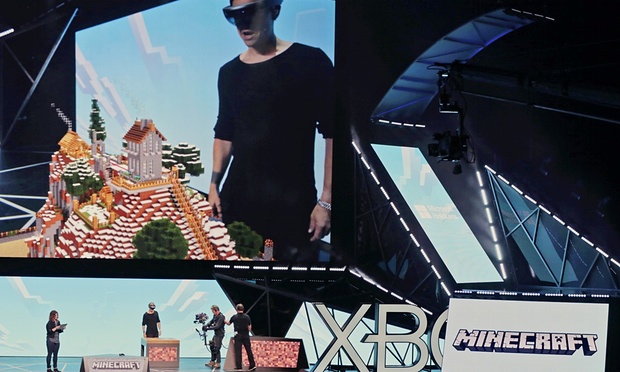
by Stone Marshall | Jun 26, 2015 | Minecraft News |
There are robot insects bursting in through the walls. Everywhere I look, the plaster is cracking, then suddenly, out they spew, their metallic claws aimed at my jugular. It sounds like the sort of techno-hallucinogenic nightmare that filmmaker David Cronenberg may concoct in one of his woozy sci-fi horror flicks. But it isn’t. This is a demo for Microsoft’s Hololens, a forthcoming “mixed reality” headset. The future is terrifying. But also sort of amazing.
I’m standing in a quiet room, upstairs from the E3 Expo in Los Angeles, with two staff from Microsoft’s Hololens development team that’s based in Redmond. They’re going to show me a couple of demos: the robot shooting game, Project X-Ray, and the one I’m really desperate to see, Minecraft Hololens – basically, the game that stole the show at Microsoft’s pre-E3 press briefing.
Announced in January, Hololens is Microsoft’s entry into the growing arena of immersive interactive technologies. It’s a self-contained, standalone headset, featuring two transparent HD holographic lenses. When you put the headset on, the device is capable of projecting computer graphics into your field of vision – so it looks like these digital objects are part of your real-world. This seamless integration of graphical elements into your normal view differentiates the technology from virtual reality headsets like Facebook’s Oculus Rift and Sony’s Project Morpheus, which immerse you in a digitally constructed world. Confused? Um, the coming world of immersive entertainment is maybe not for you.
Hololens also features an array of sensors so it can work out where you are, how you are moving, and what’s happening in the environment around you. It has a basic understanding of the objects in your field of view, too, so it recognises doors, windows, chairs, tables – elements it can use when overlaying visuals. Plus, there’s a mini-computer – or holographic processing unit – built in, so you don’t have to plug it into a computer or games console. Hololens can go anywhere with you.
The device itself looks suitably futuristic. The visor is attached to a high quality plastic band, which also contains the sensor array and the self-cooling computer processor, as well as built-in speakers with 3D spatial sound. Within this is another band, which fits over your head, with an adjuster wheel on the back to tighten it up. I slip it on carefully, and it’s surprisingly light and easy to set in position. I’ve heard some people say it’s either too tight or too loose, but for me, the lenses stay comfortably in place, directly in front of my eyes and I can move my head without it wobbling. Hololens is a work in progress and it seems some re-designing has been carried out since the original protoypes were shown in January.
They start me off with Project X-Ray. A simple menu screen is projected onto the wall in front of me, and to select the demo, I just have to lift my hand up in front of the device’s sensors, raise a finger then make a sort of clicking gesture, like pressing the button on a mouse. This selects the demo and it starts running.
Now I’m in the game, a sort of first-person sci-fi shooter. A voice tells me that there’s an invasion of robots coming and I have to prepare myself. I have an Xbox One controller, which acts as my laser gun trigger, and it fires wherever I’m looking. Suddenly, I hear a sort of digging noise and cracks start appearing in the wall in front of me, then chunks of rock burst out and I can look into what appears to be a tunnel. A tunnel behind the wall of an E3 demo room. Then robot scorpions start running out crawling onto the wall and firing at me. They scuttle about, some launch into the air around me. Their projectiles are reasonably slow, so I can dodge them, but later enemies fire waves of bullets, which I have to duck underneath to survive.
It’s surprisingly physical. As the attack heats up, robots start bursting into the room from behind me, and either side, so I have to listen out for the tell-tale scratching noises – already I’m imagining how terrifying this would be in a horror game like Resident Evil. Some robots even burrow along the interior walls so you see masonry cracks spreading out along the entire surface. It’s weird, but incredibly involving. By the end, multiple robots are firing at me, so I use a power-up on the pad’s left trigger that slows down time, allowing me to shoot multiple scorpions, earning a combo bonus. By the end, I’m almost breathless having darted about the room firing wildly for five minutes, completely immersed and almost unaware of the two Microsoft coders watching my every move.
Certainly, I’ve played basic “mixed” or “augmented” reality experiences in the past. In 2003, an early mobile phone game called Mosquito Hunt overlaid its graphics onto the camera display, so you could jerk your phone around blasting at imaginary insects. Nintendo’s 3DS console came with a range of interesting AR demos that let mini-game characters appear out of your environment. But this is different. The fact that the screen overlays your visual field, that the computer graphics are contextual and high definition, and that the tech is using the actual walls in the room as props, all heighten the experience immeasurably.
“We knew from the beginning that Hololens would need to have an understanding of the user’s real environment – we knew it would make the gameplay unique for each person, based on where they play,” explains Microsoft’s corporate vice-president Kudo Tsunoda, just before my demo. “However, as we started building more character-driven narrative experiences, we didn’t fully understand the level of emotional engagement and intensity that you can create with somebody by having the characters and the story play out like right there in their real world.
“One of the great things about gamers is that you get so attached to your favourite characters and stories. So when you start seeing those characters coming to sit down on your sofa or interacting with different parts of your house, there’s a level of immediacy and intimacy that goes beyond anything you can experience while sitting in front of a television screen.”
This becomes obvious in our second demo, the one I’d been waiting for: Minecraft. Once again, the program projects a 2D menu screen onto a wall, which lets me select a Minecraft world and load it up. Then, I’m told to look at the table behind me and ask the application to place the world right there. Suddenly, the surface of the table seems to drop down, and out of it rises an entire Minecraft landscape, jutting up into the room, looking as solid and colourful as a Lego model. I can walk around it and peer down at the sheep milling about; I can look into the windows of a house. One of the demo staff is controlling a character and I can watch him run and leap about the scenery. With a series of simple voice commands, I can ask the camera to track the character’s movement so I can look in right behind him and follow his actions more closely.
Cleverly, Hololens also comes with an array of physical commands, like a touchscreen phone. To move the map around, I simply make a pinching motion in front of my eyes and then move my hand – the Minecraft map moves with me, up and down or side to side. If I pull it up high enough, I can see the subterranean environment, the tunnels and caverns, the flowing streams of lava. I can ask for a marker to be placed where I’m looking, so interesting spots can be explored later, I can even request for a signpost to be placed in specific areas, and then “write” a message on it using a speech-to-text interface. (Though this doesn’t seem amazingly accurate right now – I want to write “there’s gold in them there hills”, but something about a “nice weekend” comes up instead.)
It’s rather beautiful, and it suggests that Hololens could become a creative tool, allowing gamers to easily modify and create their own levels. “Most people don’t have an inherent understanding of how to create in 3D – it can be very complicated on 2D screens,” says Tsunoda. “This is one of the places that Hololens and gaming come together in a very interesting way – allowing a lot more user-generated content, not only as part of the gameplay but also involving players in the creation of the game and how the gameplay evolves. I think we’re going to see more communities adding to and customising the games they play. That will be very cool.”
The main downside right now, is the restricted field of view that the graphical elements can appear in. There is a rectangle in your immediate vision, where digital content is visible – look away from that, and you lose it. Unlike virtual reality technology that completely surrounds your vision, Hololens is only active in this one central sweet spot, it’s not peripheral.
This is fine in demos like Project X-Ray where you have limited, discreet areas of action – i.e. small robots coming through your wall. But with the Minecraft demo, it was a little frustrating, viewing this vast and beautiful 3D model, but having to keep moving your head to keep it in the centre of your vision so that the whole thing didn’t disappear. Tsunoda has said that the field may be increased before release, but not by much. I think this will very much dictate the sorts of experiences we can expect, especially in games.
Other than that, three key questions remain: price, release date, battery life. Microsoft is saying that Hololens will appear “in the Windows 10” timeframe, so late summer or early autumn, then. But we’ll see. There’s no clue on the other vital elements.
But clearly this is a fascinating new technology, not just for games, but for many areas of science, education and the arts. It will be interesting to see more from rival mixed reality solution Magic Leap which is being backed by Google; it will also be intriguing to discover what happens when these augmented reality solutions go up against the virtual reality visions of Oculus, Sony and HTC.
“VR and mixed reality are complimentary technologies,” says Tsunoda. “However, the more you can allow people to interact with their real world and real people, the more that you get everyday use cases for a technology. It’s this that can take a product into the mass market.”
Minecraft on Hololens: the future of gaming is right in front of your eyes





![[Update: Released] Minecraft: Pocket Edition 0.11.0 update will finally be jumping out of beta and going live this week](https://www.stonemarshall.com/wp-content/uploads/Minecraft-Pocket-Edition-Boats-Android.jpg)






